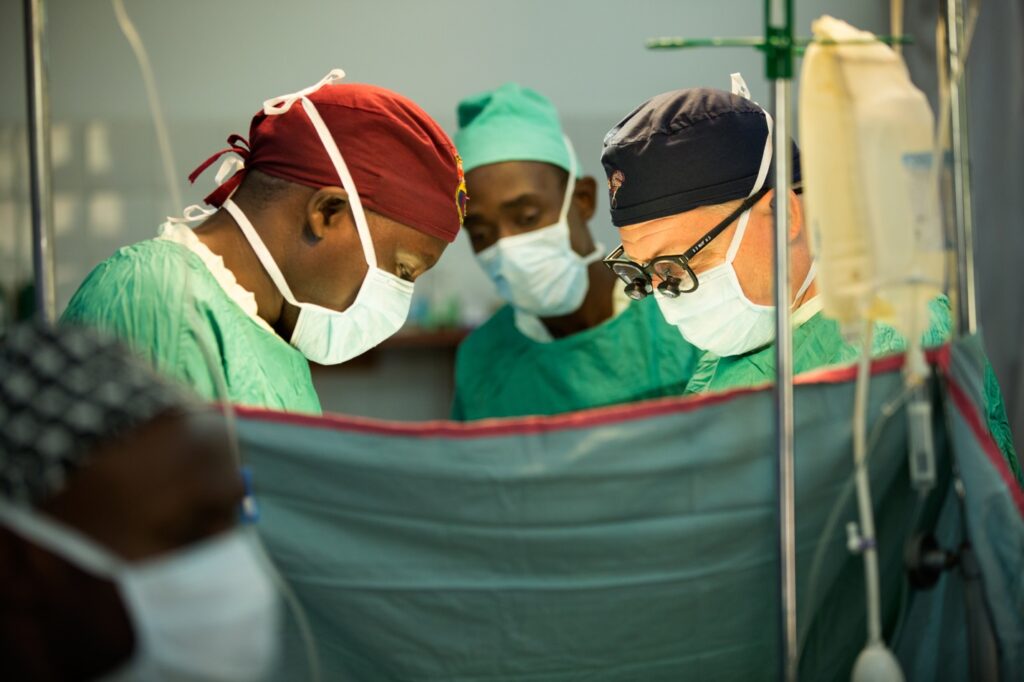October 25, 2021
In recognition of today’s World Spina Bifida and Hydrocephalus Day, we’re taking a look back at how we got here and why Neuro Kids is uniquely positioned to deliver contextually-appropriate neurosurgical solutions for kids with disabilities in the majority world, that all would enjoy the highest attainable standard of health.

No stranger to people living with disabilities, Dr. Benjamin Warf and his wife Cindy made a life-changing decision in 2000 and moved to East Africa. After completing his fellowship in pediatric neurosurgery at Boston Children’s Hospital (the hospital’s first!) in 1992 and serving as the director of pediatric neurosurgery at the University of Kentucky Medical Center for several years, Dr. Warf, Cindy and their six young children moved to a small town in eastern Uganda to start the CURE Children’s Hospital of Uganda, a neurosurgical hospital for children (the first in sub-Saharan Africa). For most of that first year, Dr. Warf did not operate on a single case, focused instead on getting the hospital built, staffed, and operational. Several years ago, I asked him if there were moments in that first year when he doubted whether he was best utilizing his time and talents as a surgeon. He replied, “Almost every day … but we knew that if I could just treat that first child, we could make a difference.”

In Uganda, Dr. Warf encountered a high incidence of hydrocephalus. The traditional treatment of hydrocephalus—insertion of shunts—is often prohibitively expensive and prone to fail in the first few years, requiring access to emergency neurosurgery. This is beyond the reach of most children in the majority world, so Dr. Warf pioneered an alternative, low-cost treatment. In carefully designed clinical trials, he demonstrated that a relatively straightforward, one-time treatment using modern endoscopic techniques results in outcomes that are as safe and effective as shunts but requires far less medical infrastructure and life-long post-surgical maintenance.

Endoscopic third ventriculostomy combined with choroid plexus cauterization (ETV/CPC)
ETV is a minimally-invasive procedure that creates an opening in the floor of the third ventricle in the brain. This allows cerebrospinal fluid (CSF) trapped within the brain’s ventricles to escape into its normal pathway. CPC is a procedure that reduces the choroid plexus (tissue that produces CSF) in two of the four ventricles inside the brain. This decreases the amount of fluid produced and may also reduce the strength of pulses that can cause the ventricles to enlarge. Combined, the ETV/CPC procedure is more effective in treating hydrocephalus from all causes in babies, especially those who also have hydrocephalus in association with spina bifida. This represents a superior public health strategy in low-resource settings than primary shunt placement — a safer and less expensive treatment that avoids a lifetime of shunt-dependence for two-thirds of these cases.

Increasing Access to ETV/CPC
Dr. Warf also designed a training program and network for neurosurgeons in Africa, Asia, and the Middle East, increasing exponentially the number of children who can now be treated using his method. Over the past fifteen years, dozens of surgeons from around the world have been trained in the ETV/CPC procedure, saving the lives of more than ten thousand children. However, every year, nearly half a million children will be affected by hydrocephalus, most of them from the majority world—countries in Africa, Asia, and Latin America. There is much still to do.
The Warfs have since moved back to the United States, where Dr. Warf is practicing pediatric neurosurgery. He is a Professor of Neurosurgery at Harvard Medical School and holds the Hydrocephalus and Spina Bifida Chair at Boston Children’s Hospital, where he serves as Director of Neonatal and Congenital Anomalies Neurosurgery. He also serves as Affiliate Faculty in the Department of Global Health and Social Medicine and the Program in Global Surgery and Social Change at Harvard Medical School.
Neuro Kids
Earlier this year, with Dr. Warf’s vision and leadership, we launched Neuro Kids to transform the lives of some of the most vulnerable kids in the world by connecting neurosurgeons with the mentoring, equipment and training necessary to perform the ETV/CPC procedure and make the best care accessible to all children with hydrocephalus, spina bifida, and other neurosurgically treatable conditions. We assembled an amazing team to help climb this mountain — over 100 years of combined clinical and leadership experience in serving children with hydrocephalus and spina bifida.

In reflecting back over the past twenty years, there is continuity, but there is also change. I think of that first kid treated by Dr. Warf in Uganda and marvel at where we are today. We have learned a lot about hydrocephalus and how to treat it. We are committed to leveraging our experience to exponentially increase access and treatment options for the thousands upon thousands in need of care right now and in the days and years to come.





